Impact of Online Advertisement on Consumer Perception: Dissertation
VerifiedAdded on 2020/05/28
|19
|3773
|61
Thesis and Dissertation
AI Summary
This dissertation proposal investigates the impact of online advertising through social media on consumer perception and purchasing behavior. It begins with an introduction outlining the research background, problem statement, aims, and objectives, emphasizing the increasing use of the internet and social media in India and the shift of marketers towards these platforms. A literature review then explores the concept and categories of online advertising, including email, floating, and social network advertisements, and discusses the criteria for effective social media advertising, such as transparency and ease of access to information. The methodology section details the philosophical approach (positivism and deduction), research strategy (quantitative questionnaires), data collection methods (primary data via questionnaires using simple random sampling), data analysis techniques, and addresses potential challenges, limitations, and ethical considerations. A research timetable and reference list are also included, providing a comprehensive framework for the dissertation.
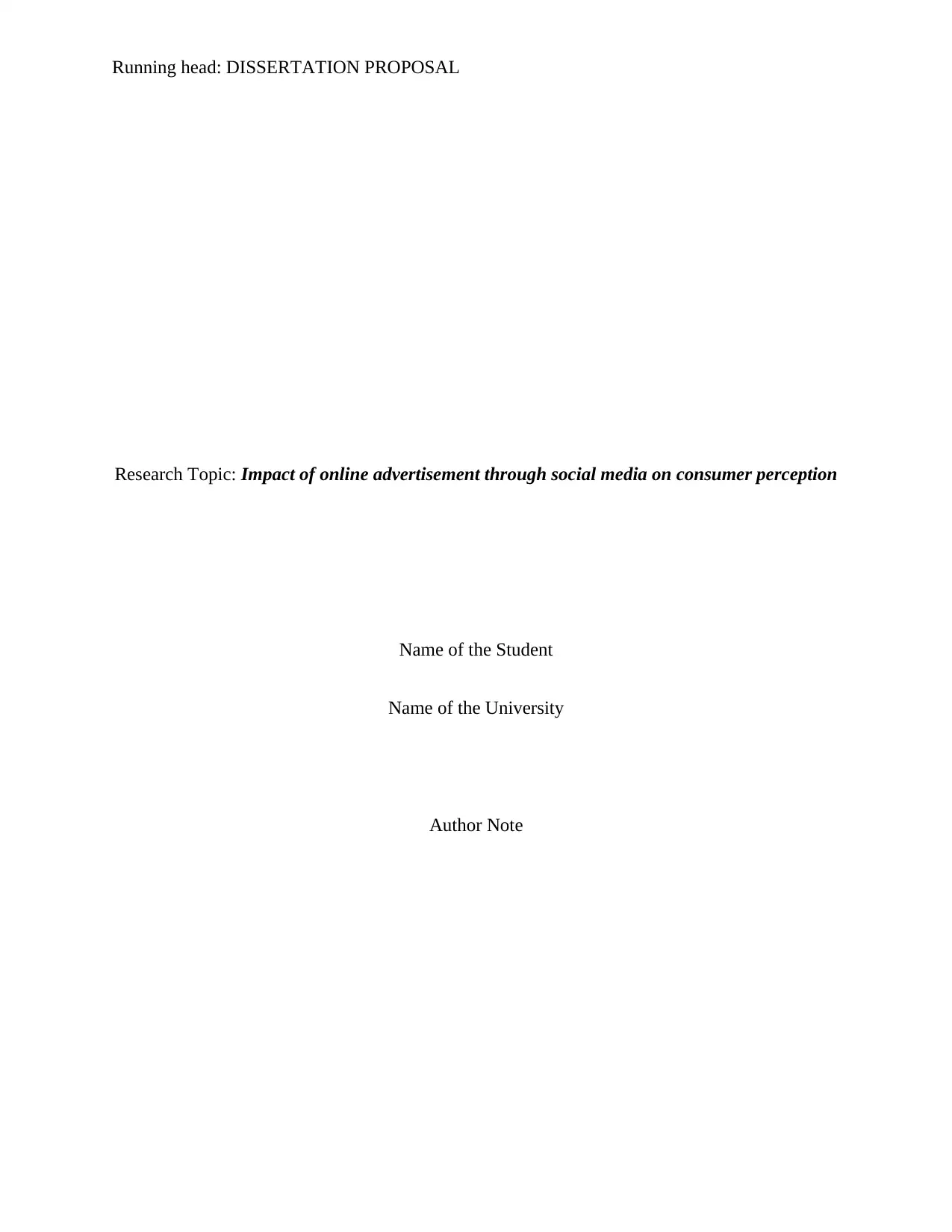
Running head: DISSERTATION PROPOSAL
Research Topic: Impact of online advertisement through social media on consumer perception
Name of the Student
Name of the University
Author Note
Research Topic: Impact of online advertisement through social media on consumer perception
Name of the Student
Name of the University
Author Note
Paraphrase This Document
Need a fresh take? Get an instant paraphrase of this document with our AI Paraphraser
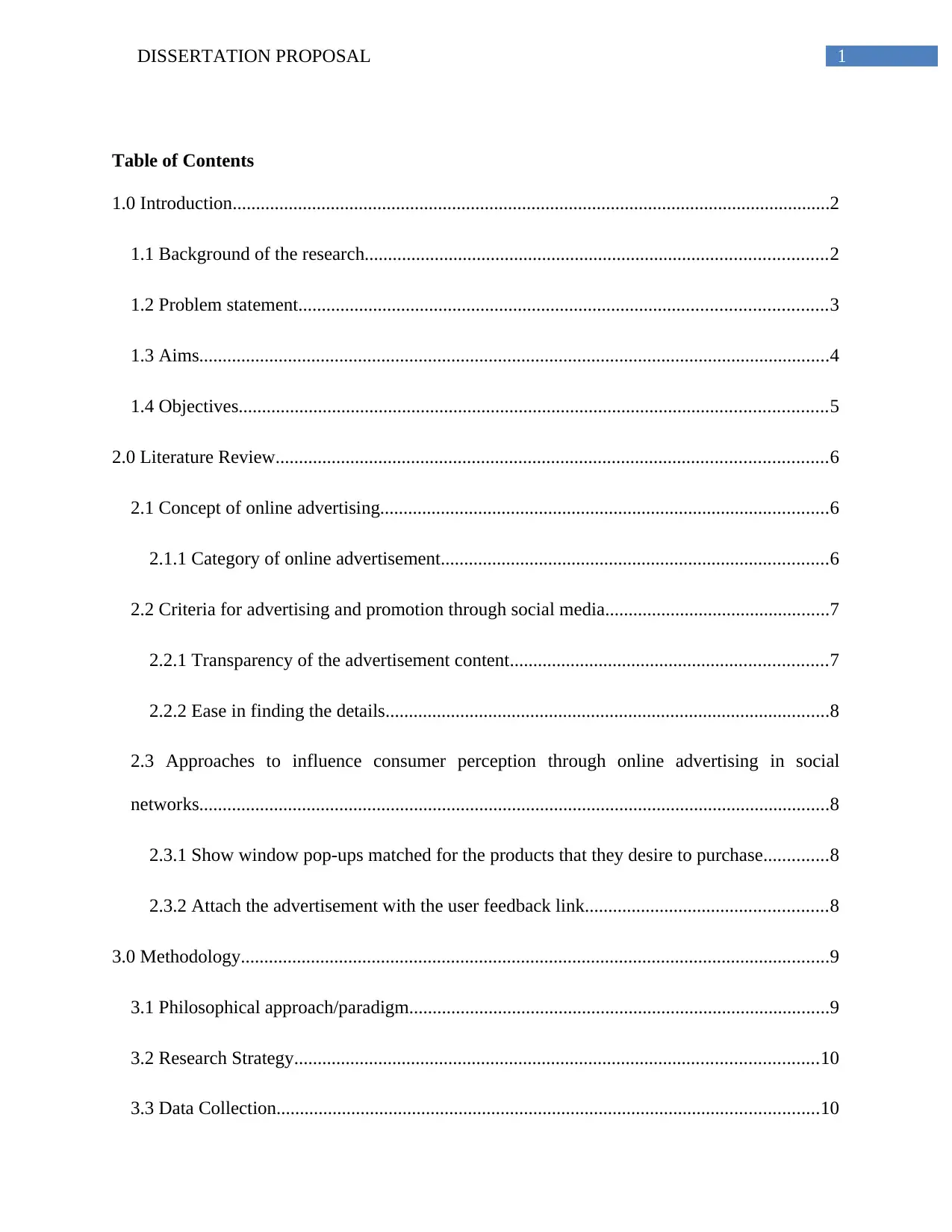
1DISSERTATION PROPOSAL
Table of Contents
1.0 Introduction................................................................................................................................2
1.1 Background of the research...................................................................................................2
1.2 Problem statement.................................................................................................................3
1.3 Aims.......................................................................................................................................4
1.4 Objectives..............................................................................................................................5
2.0 Literature Review......................................................................................................................6
2.1 Concept of online advertising................................................................................................6
2.1.1 Category of online advertisement...................................................................................6
2.2 Criteria for advertising and promotion through social media................................................7
2.2.1 Transparency of the advertisement content....................................................................7
2.2.2 Ease in finding the details...............................................................................................8
2.3 Approaches to influence consumer perception through online advertising in social
networks.......................................................................................................................................8
2.3.1 Show window pop-ups matched for the products that they desire to purchase..............8
2.3.2 Attach the advertisement with the user feedback link....................................................8
3.0 Methodology..............................................................................................................................9
3.1 Philosophical approach/paradigm..........................................................................................9
3.2 Research Strategy................................................................................................................10
3.3 Data Collection....................................................................................................................10
Table of Contents
1.0 Introduction................................................................................................................................2
1.1 Background of the research...................................................................................................2
1.2 Problem statement.................................................................................................................3
1.3 Aims.......................................................................................................................................4
1.4 Objectives..............................................................................................................................5
2.0 Literature Review......................................................................................................................6
2.1 Concept of online advertising................................................................................................6
2.1.1 Category of online advertisement...................................................................................6
2.2 Criteria for advertising and promotion through social media................................................7
2.2.1 Transparency of the advertisement content....................................................................7
2.2.2 Ease in finding the details...............................................................................................8
2.3 Approaches to influence consumer perception through online advertising in social
networks.......................................................................................................................................8
2.3.1 Show window pop-ups matched for the products that they desire to purchase..............8
2.3.2 Attach the advertisement with the user feedback link....................................................8
3.0 Methodology..............................................................................................................................9
3.1 Philosophical approach/paradigm..........................................................................................9
3.2 Research Strategy................................................................................................................10
3.3 Data Collection....................................................................................................................10
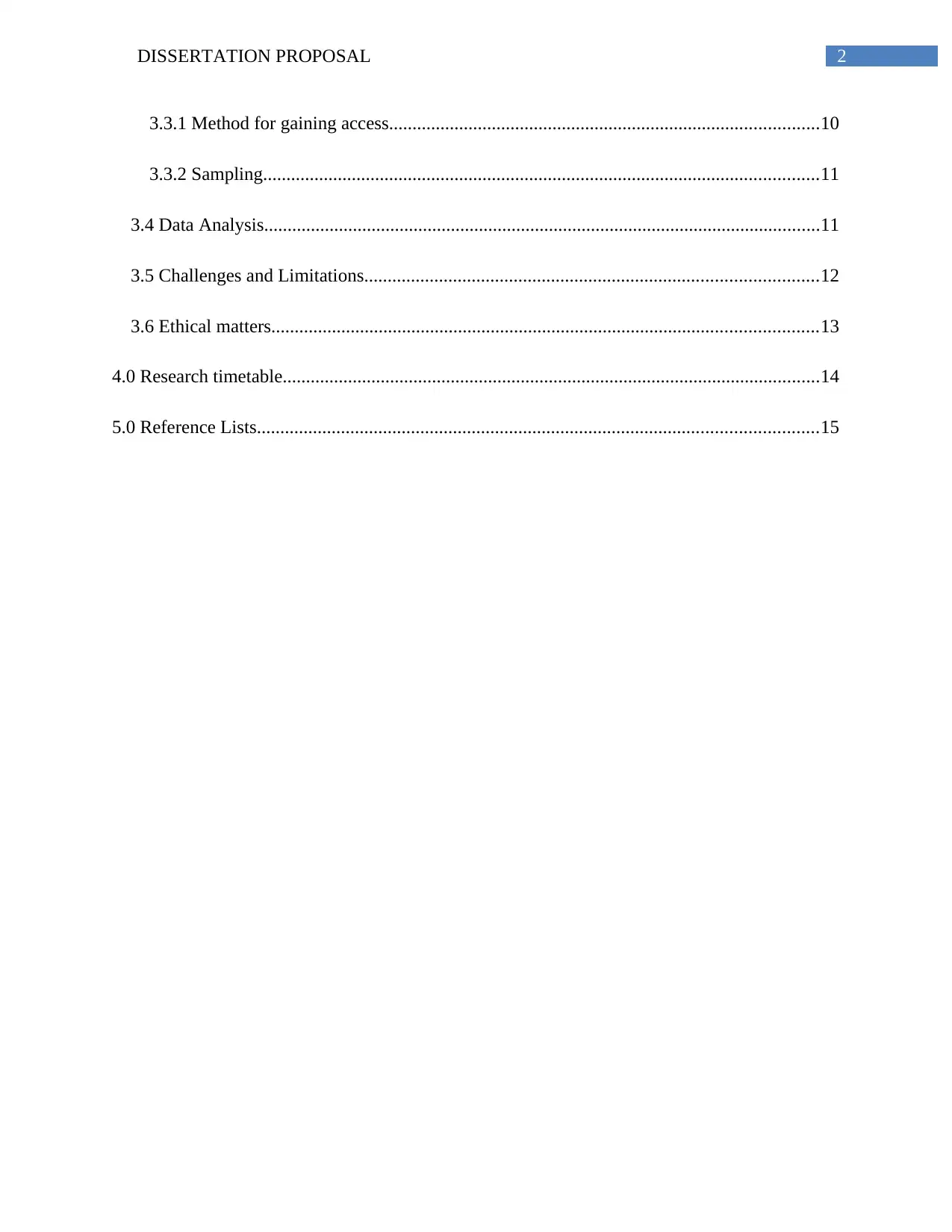
2DISSERTATION PROPOSAL
3.3.1 Method for gaining access............................................................................................10
3.3.2 Sampling.......................................................................................................................11
3.4 Data Analysis.......................................................................................................................11
3.5 Challenges and Limitations.................................................................................................12
3.6 Ethical matters.....................................................................................................................13
4.0 Research timetable...................................................................................................................14
5.0 Reference Lists........................................................................................................................15
3.3.1 Method for gaining access............................................................................................10
3.3.2 Sampling.......................................................................................................................11
3.4 Data Analysis.......................................................................................................................11
3.5 Challenges and Limitations.................................................................................................12
3.6 Ethical matters.....................................................................................................................13
4.0 Research timetable...................................................................................................................14
5.0 Reference Lists........................................................................................................................15
⊘ This is a preview!⊘
Do you want full access?
Subscribe today to unlock all pages.

Trusted by 1+ million students worldwide
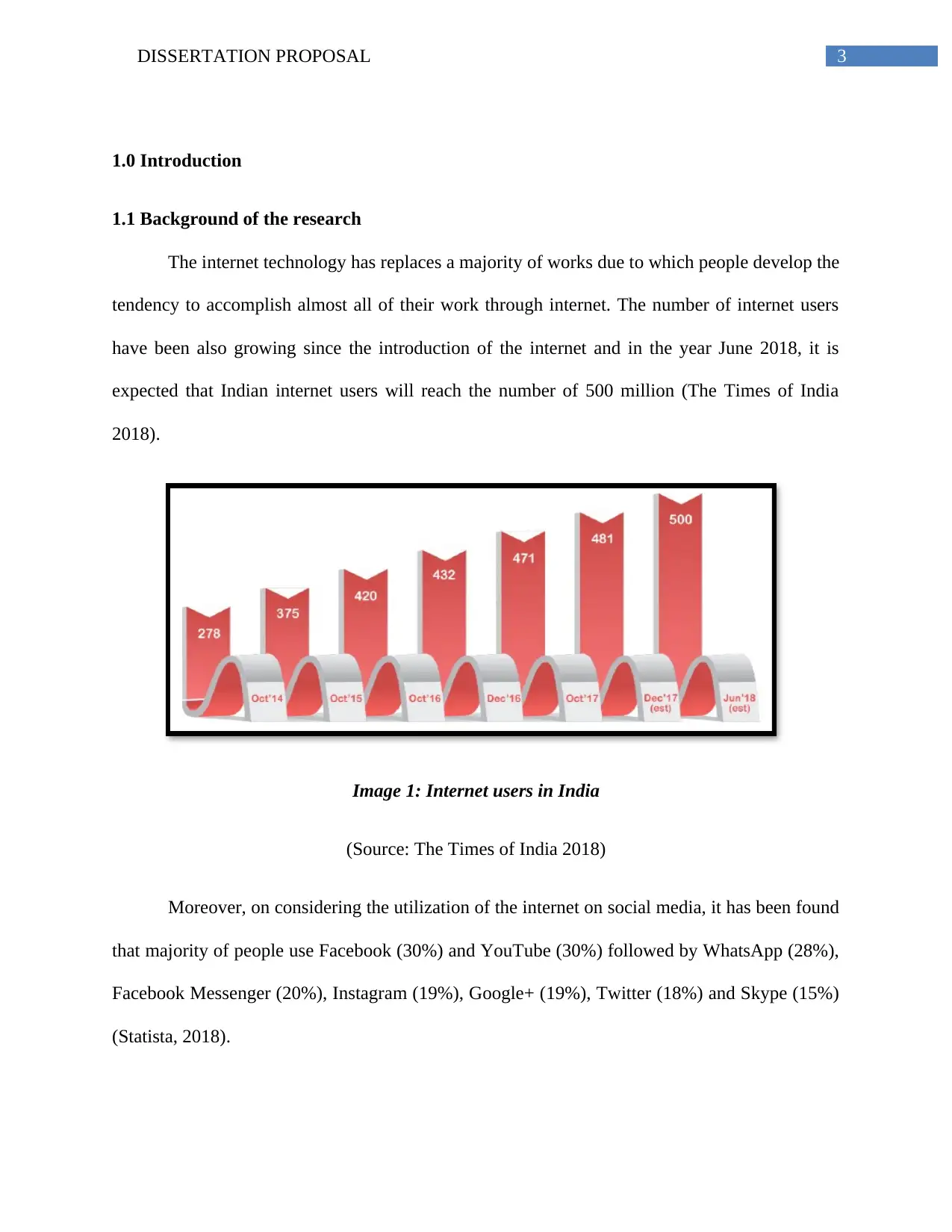
3DISSERTATION PROPOSAL
1.0 Introduction
1.1 Background of the research
The internet technology has replaces a majority of works due to which people develop the
tendency to accomplish almost all of their work through internet. The number of internet users
have been also growing since the introduction of the internet and in the year June 2018, it is
expected that Indian internet users will reach the number of 500 million (The Times of India
2018).
Image 1: Internet users in India
(Source: The Times of India 2018)
Moreover, on considering the utilization of the internet on social media, it has been found
that majority of people use Facebook (30%) and YouTube (30%) followed by WhatsApp (28%),
Facebook Messenger (20%), Instagram (19%), Google+ (19%), Twitter (18%) and Skype (15%)
(Statista, 2018).
1.0 Introduction
1.1 Background of the research
The internet technology has replaces a majority of works due to which people develop the
tendency to accomplish almost all of their work through internet. The number of internet users
have been also growing since the introduction of the internet and in the year June 2018, it is
expected that Indian internet users will reach the number of 500 million (The Times of India
2018).
Image 1: Internet users in India
(Source: The Times of India 2018)
Moreover, on considering the utilization of the internet on social media, it has been found
that majority of people use Facebook (30%) and YouTube (30%) followed by WhatsApp (28%),
Facebook Messenger (20%), Instagram (19%), Google+ (19%), Twitter (18%) and Skype (15%)
(Statista, 2018).
Paraphrase This Document
Need a fresh take? Get an instant paraphrase of this document with our AI Paraphraser
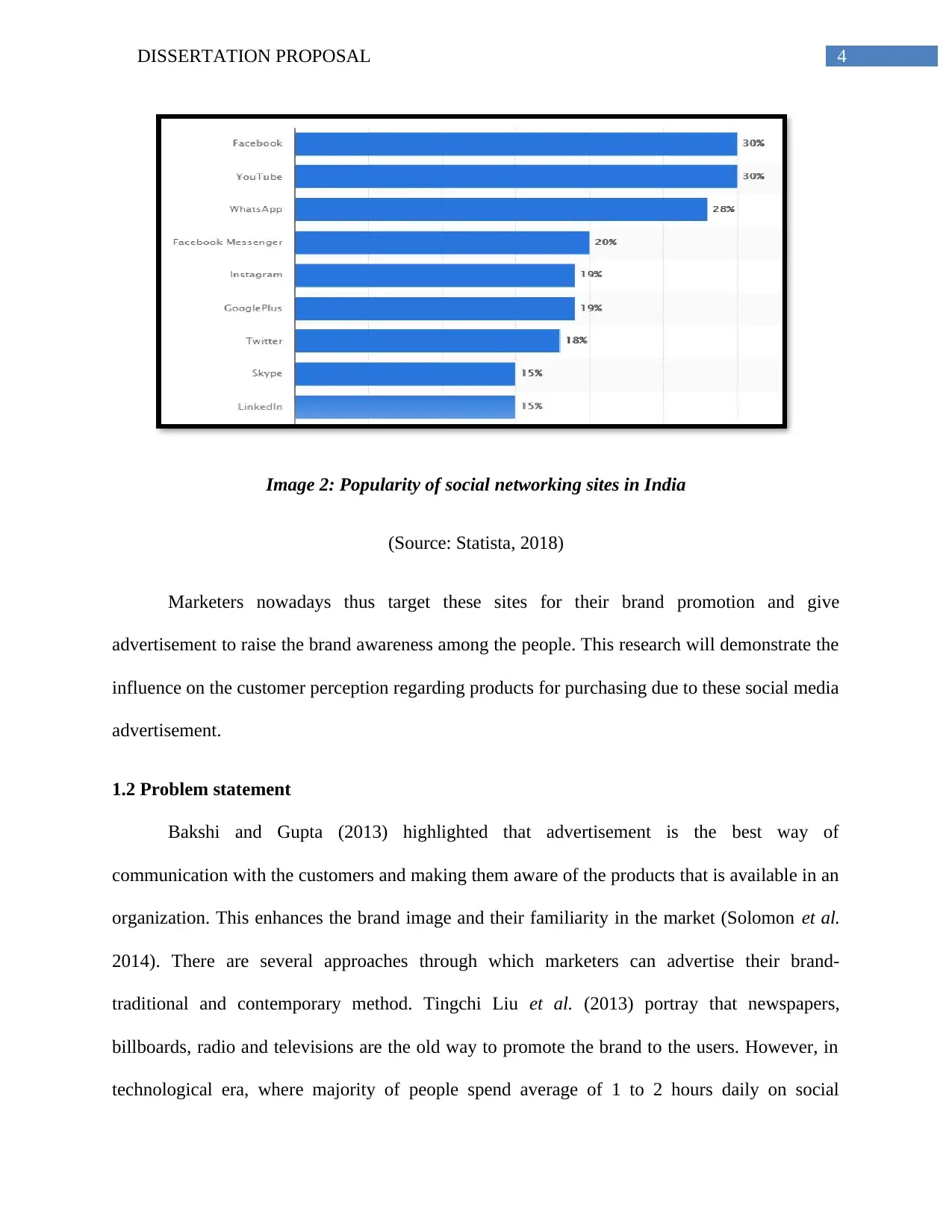
4DISSERTATION PROPOSAL
Image 2: Popularity of social networking sites in India
(Source: Statista, 2018)
Marketers nowadays thus target these sites for their brand promotion and give
advertisement to raise the brand awareness among the people. This research will demonstrate the
influence on the customer perception regarding products for purchasing due to these social media
advertisement.
1.2 Problem statement
Bakshi and Gupta (2013) highlighted that advertisement is the best way of
communication with the customers and making them aware of the products that is available in an
organization. This enhances the brand image and their familiarity in the market (Solomon et al.
2014). There are several approaches through which marketers can advertise their brand-
traditional and contemporary method. Tingchi Liu et al. (2013) portray that newspapers,
billboards, radio and televisions are the old way to promote the brand to the users. However, in
technological era, where majority of people spend average of 1 to 2 hours daily on social
Image 2: Popularity of social networking sites in India
(Source: Statista, 2018)
Marketers nowadays thus target these sites for their brand promotion and give
advertisement to raise the brand awareness among the people. This research will demonstrate the
influence on the customer perception regarding products for purchasing due to these social media
advertisement.
1.2 Problem statement
Bakshi and Gupta (2013) highlighted that advertisement is the best way of
communication with the customers and making them aware of the products that is available in an
organization. This enhances the brand image and their familiarity in the market (Solomon et al.
2014). There are several approaches through which marketers can advertise their brand-
traditional and contemporary method. Tingchi Liu et al. (2013) portray that newspapers,
billboards, radio and televisions are the old way to promote the brand to the users. However, in
technological era, where majority of people spend average of 1 to 2 hours daily on social
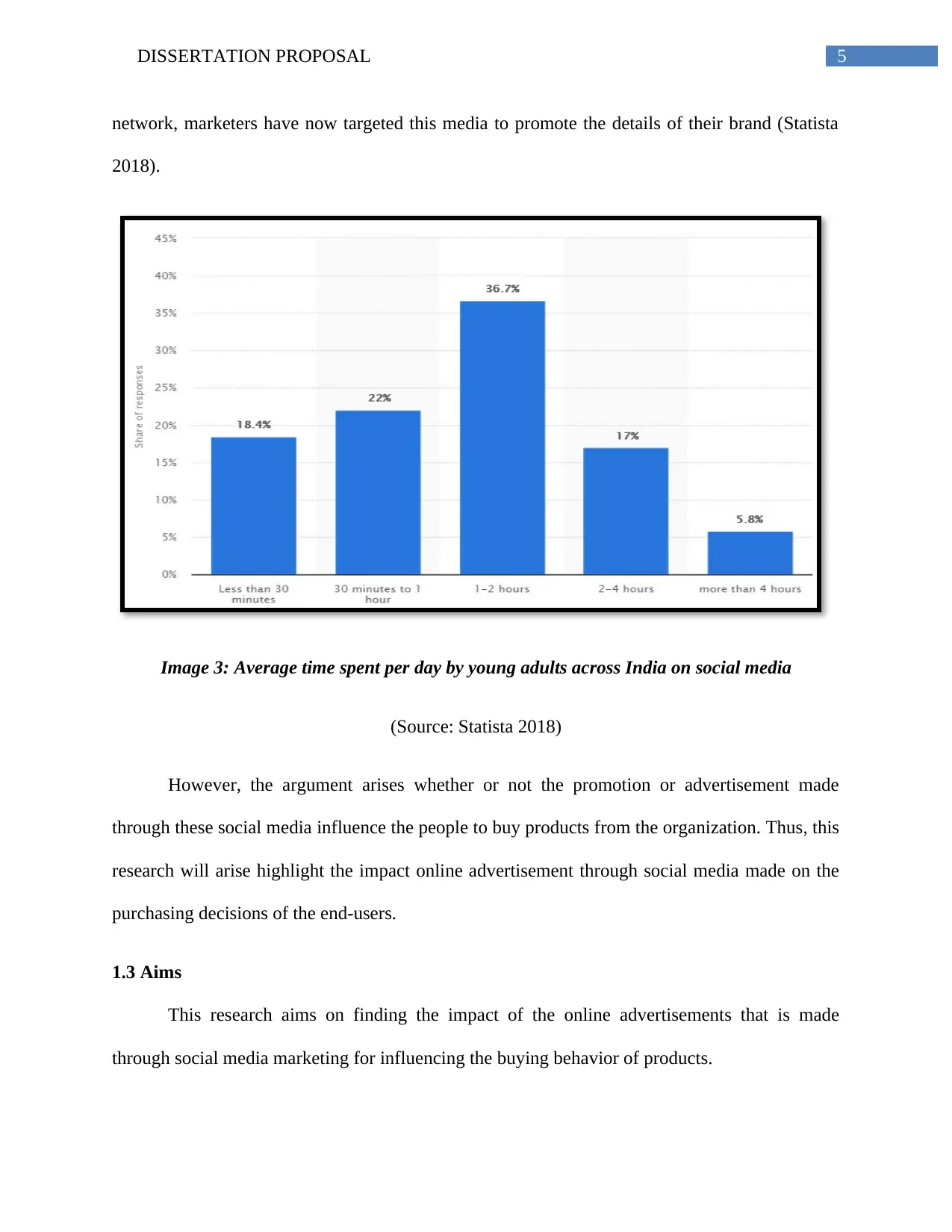
5DISSERTATION PROPOSAL
network, marketers have now targeted this media to promote the details of their brand (Statista
2018).
Image 3: Average time spent per day by young adults across India on social media
(Source: Statista 2018)
However, the argument arises whether or not the promotion or advertisement made
through these social media influence the people to buy products from the organization. Thus, this
research will arise highlight the impact online advertisement through social media made on the
purchasing decisions of the end-users.
1.3 Aims
This research aims on finding the impact of the online advertisements that is made
through social media marketing for influencing the buying behavior of products.
network, marketers have now targeted this media to promote the details of their brand (Statista
2018).
Image 3: Average time spent per day by young adults across India on social media
(Source: Statista 2018)
However, the argument arises whether or not the promotion or advertisement made
through these social media influence the people to buy products from the organization. Thus, this
research will arise highlight the impact online advertisement through social media made on the
purchasing decisions of the end-users.
1.3 Aims
This research aims on finding the impact of the online advertisements that is made
through social media marketing for influencing the buying behavior of products.
⊘ This is a preview!⊘
Do you want full access?
Subscribe today to unlock all pages.

Trusted by 1+ million students worldwide
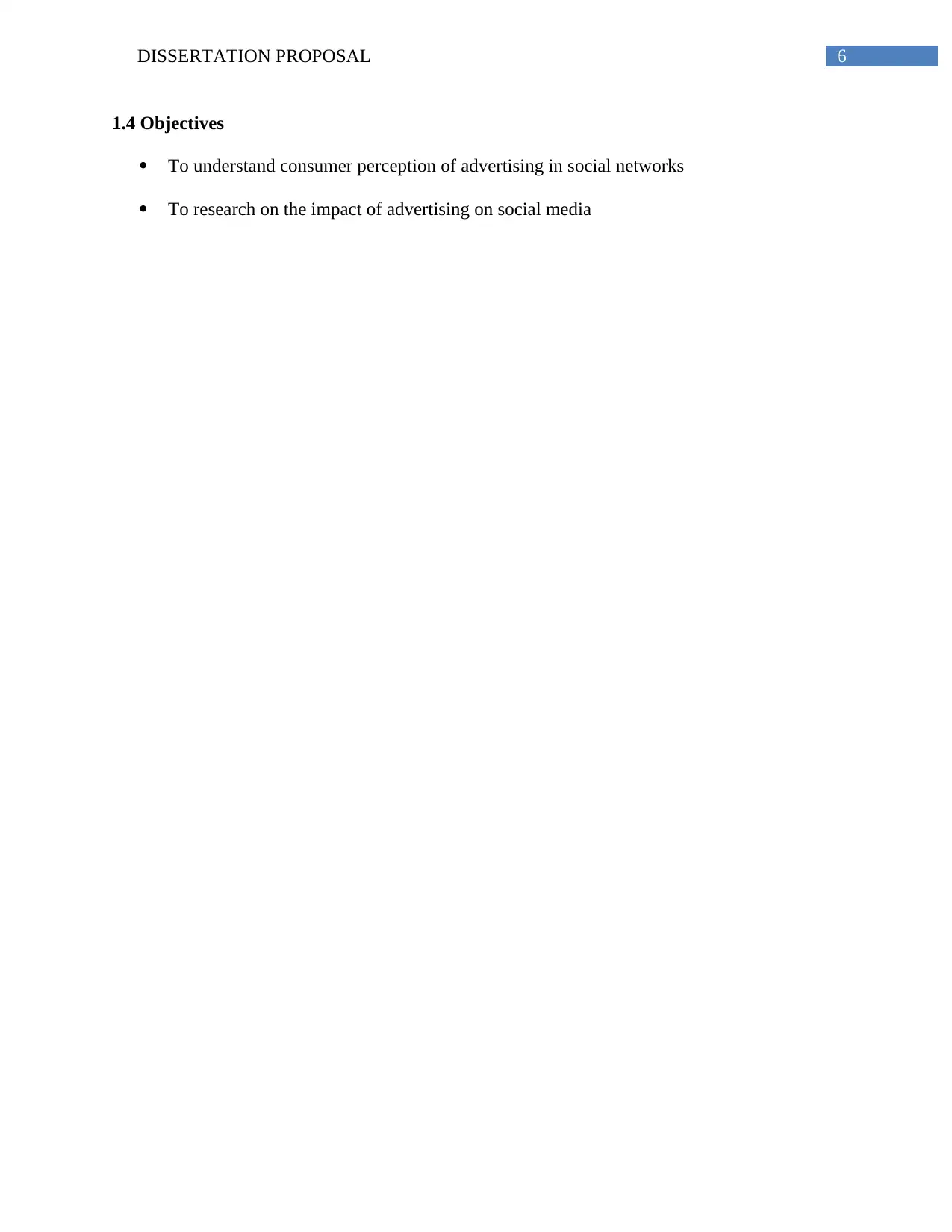
6DISSERTATION PROPOSAL
1.4 Objectives
To understand consumer perception of advertising in social networks
To research on the impact of advertising on social media
1.4 Objectives
To understand consumer perception of advertising in social networks
To research on the impact of advertising on social media
Paraphrase This Document
Need a fresh take? Get an instant paraphrase of this document with our AI Paraphraser
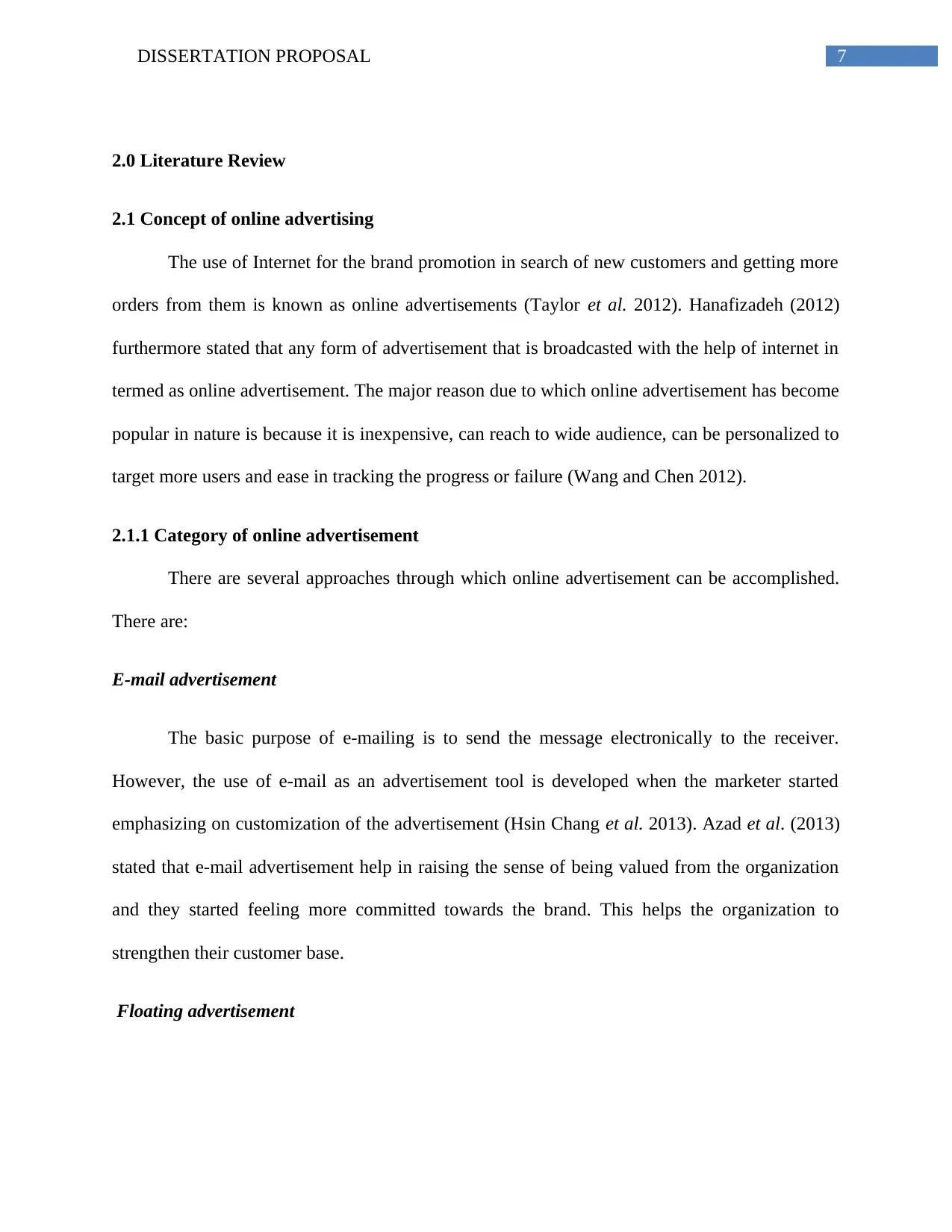
7DISSERTATION PROPOSAL
2.0 Literature Review
2.1 Concept of online advertising
The use of Internet for the brand promotion in search of new customers and getting more
orders from them is known as online advertisements (Taylor et al. 2012). Hanafizadeh (2012)
furthermore stated that any form of advertisement that is broadcasted with the help of internet in
termed as online advertisement. The major reason due to which online advertisement has become
popular in nature is because it is inexpensive, can reach to wide audience, can be personalized to
target more users and ease in tracking the progress or failure (Wang and Chen 2012).
2.1.1 Category of online advertisement
There are several approaches through which online advertisement can be accomplished.
There are:
E-mail advertisement
The basic purpose of e-mailing is to send the message electronically to the receiver.
However, the use of e-mail as an advertisement tool is developed when the marketer started
emphasizing on customization of the advertisement (Hsin Chang et al. 2013). Azad et al. (2013)
stated that e-mail advertisement help in raising the sense of being valued from the organization
and they started feeling more committed towards the brand. This helps the organization to
strengthen their customer base.
Floating advertisement
2.0 Literature Review
2.1 Concept of online advertising
The use of Internet for the brand promotion in search of new customers and getting more
orders from them is known as online advertisements (Taylor et al. 2012). Hanafizadeh (2012)
furthermore stated that any form of advertisement that is broadcasted with the help of internet in
termed as online advertisement. The major reason due to which online advertisement has become
popular in nature is because it is inexpensive, can reach to wide audience, can be personalized to
target more users and ease in tracking the progress or failure (Wang and Chen 2012).
2.1.1 Category of online advertisement
There are several approaches through which online advertisement can be accomplished.
There are:
E-mail advertisement
The basic purpose of e-mailing is to send the message electronically to the receiver.
However, the use of e-mail as an advertisement tool is developed when the marketer started
emphasizing on customization of the advertisement (Hsin Chang et al. 2013). Azad et al. (2013)
stated that e-mail advertisement help in raising the sense of being valued from the organization
and they started feeling more committed towards the brand. This helps the organization to
strengthen their customer base.
Floating advertisement
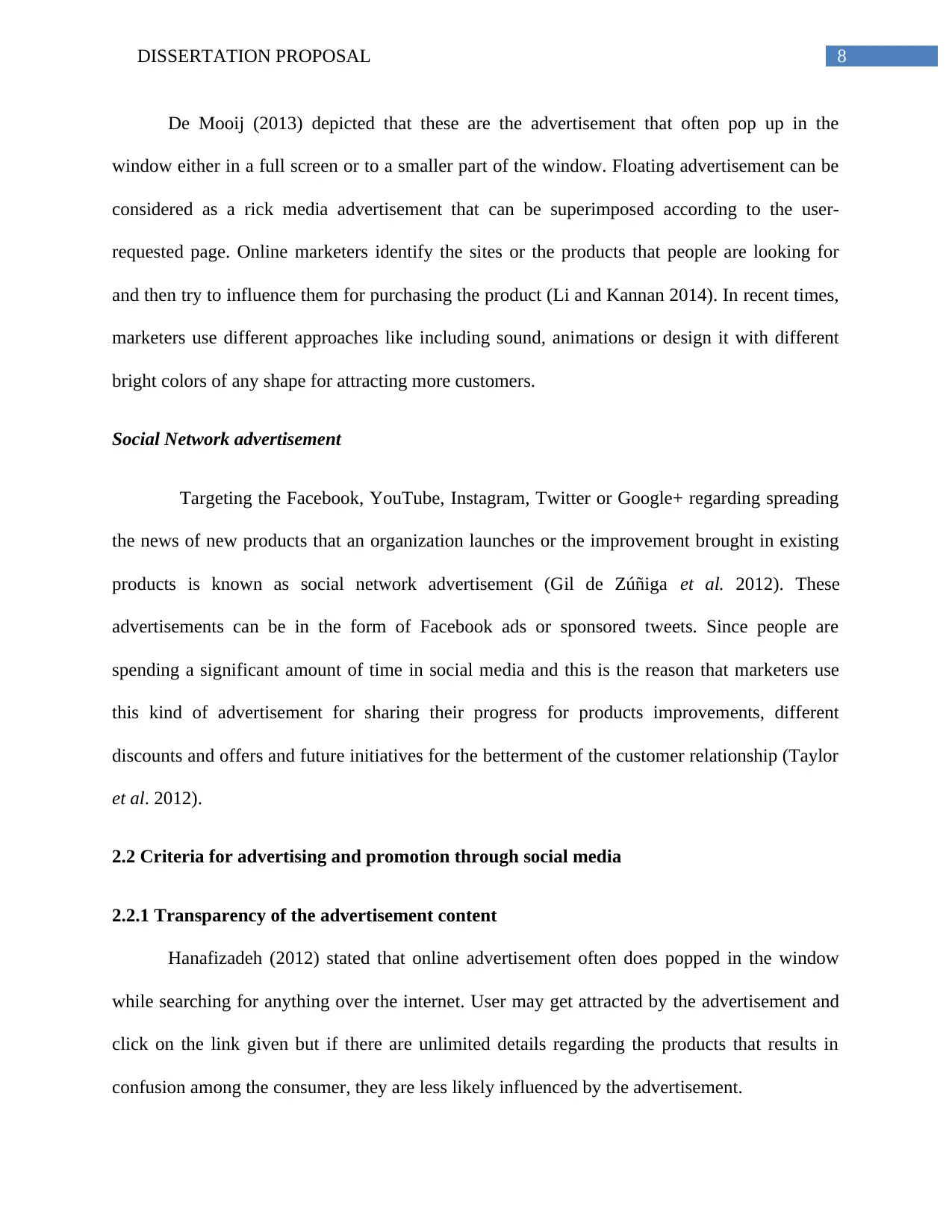
8DISSERTATION PROPOSAL
De Mooij (2013) depicted that these are the advertisement that often pop up in the
window either in a full screen or to a smaller part of the window. Floating advertisement can be
considered as a rick media advertisement that can be superimposed according to the user-
requested page. Online marketers identify the sites or the products that people are looking for
and then try to influence them for purchasing the product (Li and Kannan 2014). In recent times,
marketers use different approaches like including sound, animations or design it with different
bright colors of any shape for attracting more customers.
Social Network advertisement
Targeting the Facebook, YouTube, Instagram, Twitter or Google+ regarding spreading
the news of new products that an organization launches or the improvement brought in existing
products is known as social network advertisement (Gil de Zúñiga et al. 2012). These
advertisements can be in the form of Facebook ads or sponsored tweets. Since people are
spending a significant amount of time in social media and this is the reason that marketers use
this kind of advertisement for sharing their progress for products improvements, different
discounts and offers and future initiatives for the betterment of the customer relationship (Taylor
et al. 2012).
2.2 Criteria for advertising and promotion through social media
2.2.1 Transparency of the advertisement content
Hanafizadeh (2012) stated that online advertisement often does popped in the window
while searching for anything over the internet. User may get attracted by the advertisement and
click on the link given but if there are unlimited details regarding the products that results in
confusion among the consumer, they are less likely influenced by the advertisement.
De Mooij (2013) depicted that these are the advertisement that often pop up in the
window either in a full screen or to a smaller part of the window. Floating advertisement can be
considered as a rick media advertisement that can be superimposed according to the user-
requested page. Online marketers identify the sites or the products that people are looking for
and then try to influence them for purchasing the product (Li and Kannan 2014). In recent times,
marketers use different approaches like including sound, animations or design it with different
bright colors of any shape for attracting more customers.
Social Network advertisement
Targeting the Facebook, YouTube, Instagram, Twitter or Google+ regarding spreading
the news of new products that an organization launches or the improvement brought in existing
products is known as social network advertisement (Gil de Zúñiga et al. 2012). These
advertisements can be in the form of Facebook ads or sponsored tweets. Since people are
spending a significant amount of time in social media and this is the reason that marketers use
this kind of advertisement for sharing their progress for products improvements, different
discounts and offers and future initiatives for the betterment of the customer relationship (Taylor
et al. 2012).
2.2 Criteria for advertising and promotion through social media
2.2.1 Transparency of the advertisement content
Hanafizadeh (2012) stated that online advertisement often does popped in the window
while searching for anything over the internet. User may get attracted by the advertisement and
click on the link given but if there are unlimited details regarding the products that results in
confusion among the consumer, they are less likely influenced by the advertisement.
⊘ This is a preview!⊘
Do you want full access?
Subscribe today to unlock all pages.

Trusted by 1+ million students worldwide
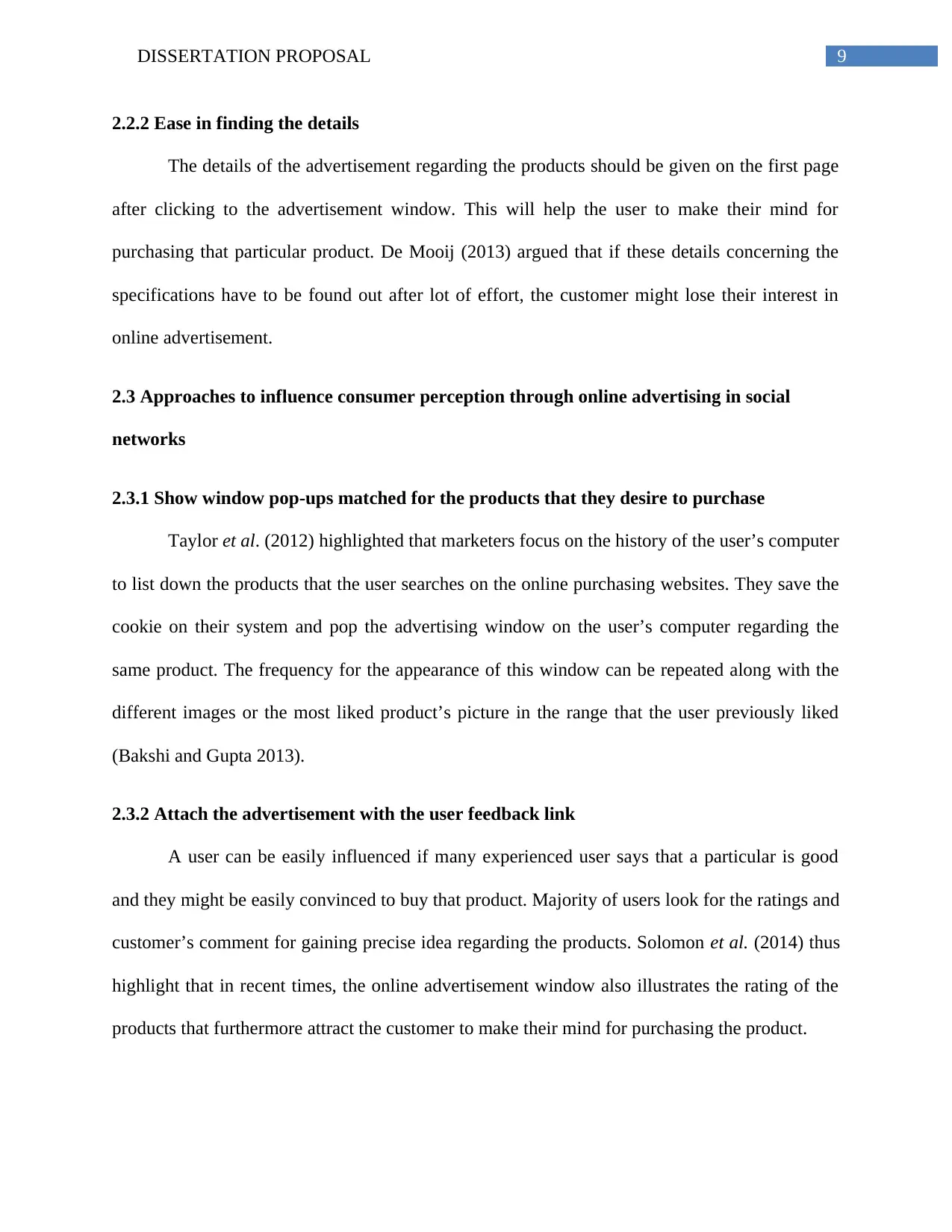
9DISSERTATION PROPOSAL
2.2.2 Ease in finding the details
The details of the advertisement regarding the products should be given on the first page
after clicking to the advertisement window. This will help the user to make their mind for
purchasing that particular product. De Mooij (2013) argued that if these details concerning the
specifications have to be found out after lot of effort, the customer might lose their interest in
online advertisement.
2.3 Approaches to influence consumer perception through online advertising in social
networks
2.3.1 Show window pop-ups matched for the products that they desire to purchase
Taylor et al. (2012) highlighted that marketers focus on the history of the user’s computer
to list down the products that the user searches on the online purchasing websites. They save the
cookie on their system and pop the advertising window on the user’s computer regarding the
same product. The frequency for the appearance of this window can be repeated along with the
different images or the most liked product’s picture in the range that the user previously liked
(Bakshi and Gupta 2013).
2.3.2 Attach the advertisement with the user feedback link
A user can be easily influenced if many experienced user says that a particular is good
and they might be easily convinced to buy that product. Majority of users look for the ratings and
customer’s comment for gaining precise idea regarding the products. Solomon et al. (2014) thus
highlight that in recent times, the online advertisement window also illustrates the rating of the
products that furthermore attract the customer to make their mind for purchasing the product.
2.2.2 Ease in finding the details
The details of the advertisement regarding the products should be given on the first page
after clicking to the advertisement window. This will help the user to make their mind for
purchasing that particular product. De Mooij (2013) argued that if these details concerning the
specifications have to be found out after lot of effort, the customer might lose their interest in
online advertisement.
2.3 Approaches to influence consumer perception through online advertising in social
networks
2.3.1 Show window pop-ups matched for the products that they desire to purchase
Taylor et al. (2012) highlighted that marketers focus on the history of the user’s computer
to list down the products that the user searches on the online purchasing websites. They save the
cookie on their system and pop the advertising window on the user’s computer regarding the
same product. The frequency for the appearance of this window can be repeated along with the
different images or the most liked product’s picture in the range that the user previously liked
(Bakshi and Gupta 2013).
2.3.2 Attach the advertisement with the user feedback link
A user can be easily influenced if many experienced user says that a particular is good
and they might be easily convinced to buy that product. Majority of users look for the ratings and
customer’s comment for gaining precise idea regarding the products. Solomon et al. (2014) thus
highlight that in recent times, the online advertisement window also illustrates the rating of the
products that furthermore attract the customer to make their mind for purchasing the product.
Paraphrase This Document
Need a fresh take? Get an instant paraphrase of this document with our AI Paraphraser
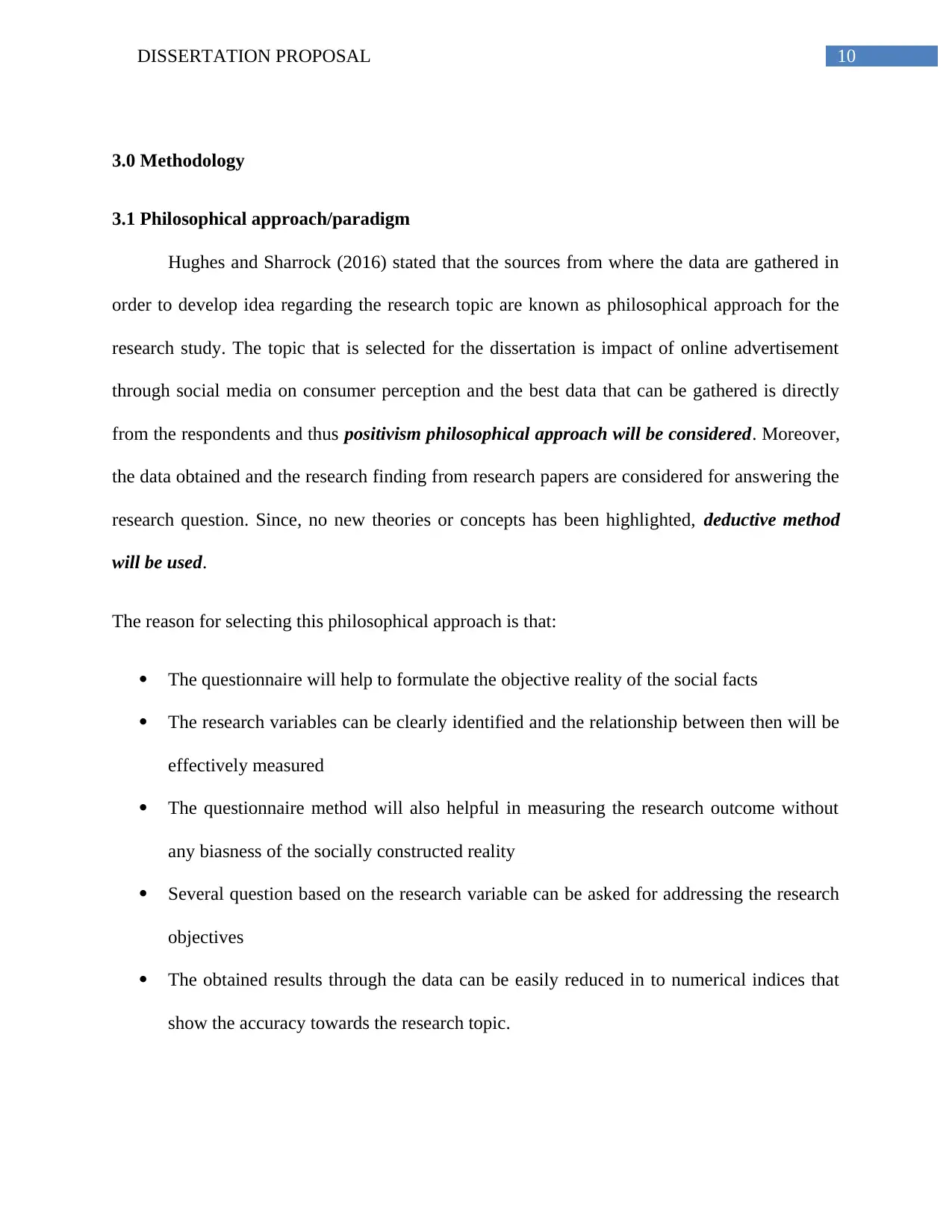
10DISSERTATION PROPOSAL
3.0 Methodology
3.1 Philosophical approach/paradigm
Hughes and Sharrock (2016) stated that the sources from where the data are gathered in
order to develop idea regarding the research topic are known as philosophical approach for the
research study. The topic that is selected for the dissertation is impact of online advertisement
through social media on consumer perception and the best data that can be gathered is directly
from the respondents and thus positivism philosophical approach will be considered. Moreover,
the data obtained and the research finding from research papers are considered for answering the
research question. Since, no new theories or concepts has been highlighted, deductive method
will be used.
The reason for selecting this philosophical approach is that:
The questionnaire will help to formulate the objective reality of the social facts
The research variables can be clearly identified and the relationship between then will be
effectively measured
The questionnaire method will also helpful in measuring the research outcome without
any biasness of the socially constructed reality
Several question based on the research variable can be asked for addressing the research
objectives
The obtained results through the data can be easily reduced in to numerical indices that
show the accuracy towards the research topic.
3.0 Methodology
3.1 Philosophical approach/paradigm
Hughes and Sharrock (2016) stated that the sources from where the data are gathered in
order to develop idea regarding the research topic are known as philosophical approach for the
research study. The topic that is selected for the dissertation is impact of online advertisement
through social media on consumer perception and the best data that can be gathered is directly
from the respondents and thus positivism philosophical approach will be considered. Moreover,
the data obtained and the research finding from research papers are considered for answering the
research question. Since, no new theories or concepts has been highlighted, deductive method
will be used.
The reason for selecting this philosophical approach is that:
The questionnaire will help to formulate the objective reality of the social facts
The research variables can be clearly identified and the relationship between then will be
effectively measured
The questionnaire method will also helpful in measuring the research outcome without
any biasness of the socially constructed reality
Several question based on the research variable can be asked for addressing the research
objectives
The obtained results through the data can be easily reduced in to numerical indices that
show the accuracy towards the research topic.
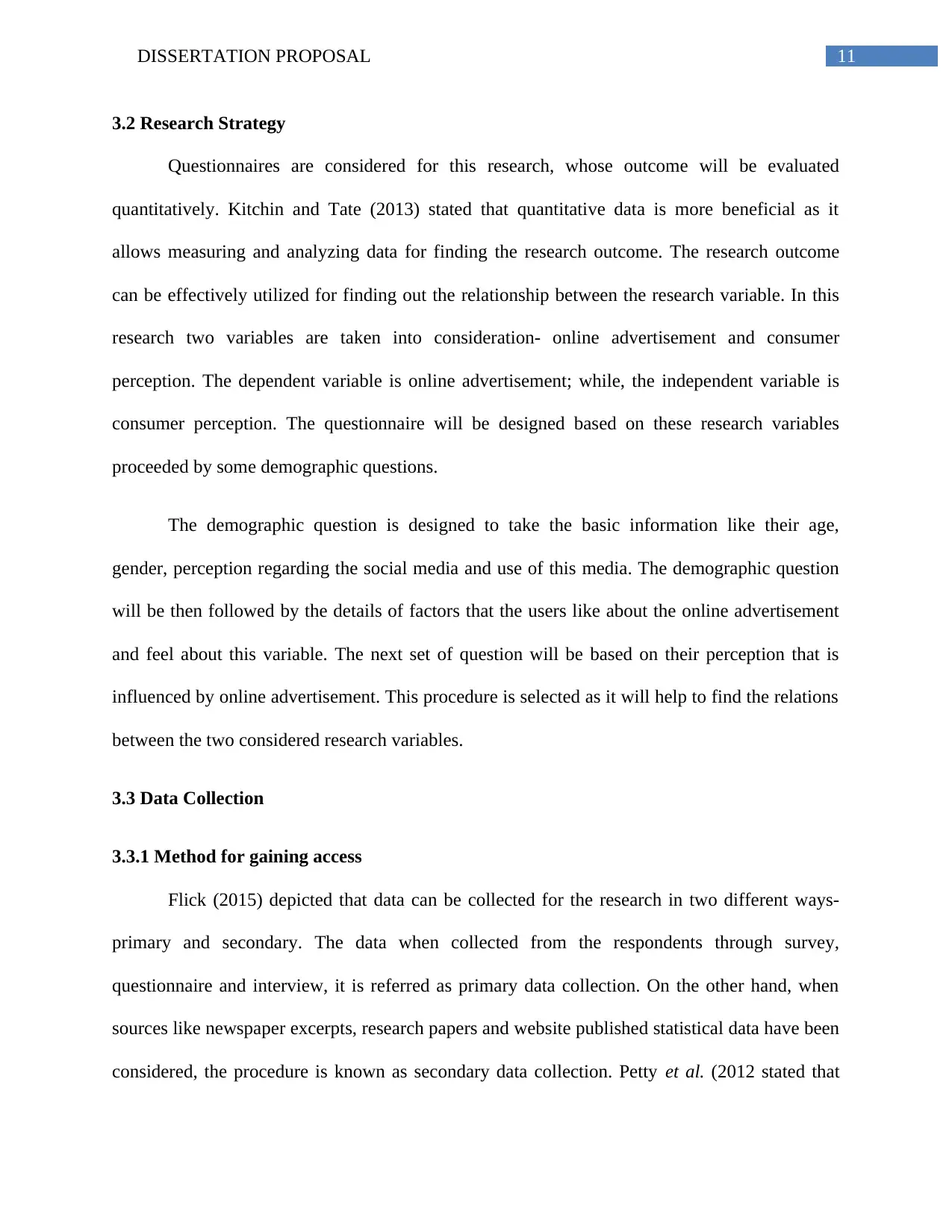
11DISSERTATION PROPOSAL
3.2 Research Strategy
Questionnaires are considered for this research, whose outcome will be evaluated
quantitatively. Kitchin and Tate (2013) stated that quantitative data is more beneficial as it
allows measuring and analyzing data for finding the research outcome. The research outcome
can be effectively utilized for finding out the relationship between the research variable. In this
research two variables are taken into consideration- online advertisement and consumer
perception. The dependent variable is online advertisement; while, the independent variable is
consumer perception. The questionnaire will be designed based on these research variables
proceeded by some demographic questions.
The demographic question is designed to take the basic information like their age,
gender, perception regarding the social media and use of this media. The demographic question
will be then followed by the details of factors that the users like about the online advertisement
and feel about this variable. The next set of question will be based on their perception that is
influenced by online advertisement. This procedure is selected as it will help to find the relations
between the two considered research variables.
3.3 Data Collection
3.3.1 Method for gaining access
Flick (2015) depicted that data can be collected for the research in two different ways-
primary and secondary. The data when collected from the respondents through survey,
questionnaire and interview, it is referred as primary data collection. On the other hand, when
sources like newspaper excerpts, research papers and website published statistical data have been
considered, the procedure is known as secondary data collection. Petty et al. (2012 stated that
3.2 Research Strategy
Questionnaires are considered for this research, whose outcome will be evaluated
quantitatively. Kitchin and Tate (2013) stated that quantitative data is more beneficial as it
allows measuring and analyzing data for finding the research outcome. The research outcome
can be effectively utilized for finding out the relationship between the research variable. In this
research two variables are taken into consideration- online advertisement and consumer
perception. The dependent variable is online advertisement; while, the independent variable is
consumer perception. The questionnaire will be designed based on these research variables
proceeded by some demographic questions.
The demographic question is designed to take the basic information like their age,
gender, perception regarding the social media and use of this media. The demographic question
will be then followed by the details of factors that the users like about the online advertisement
and feel about this variable. The next set of question will be based on their perception that is
influenced by online advertisement. This procedure is selected as it will help to find the relations
between the two considered research variables.
3.3 Data Collection
3.3.1 Method for gaining access
Flick (2015) depicted that data can be collected for the research in two different ways-
primary and secondary. The data when collected from the respondents through survey,
questionnaire and interview, it is referred as primary data collection. On the other hand, when
sources like newspaper excerpts, research papers and website published statistical data have been
considered, the procedure is known as secondary data collection. Petty et al. (2012 stated that
⊘ This is a preview!⊘
Do you want full access?
Subscribe today to unlock all pages.

Trusted by 1+ million students worldwide
1 out of 19
Related Documents
Your All-in-One AI-Powered Toolkit for Academic Success.
+13062052269
info@desklib.com
Available 24*7 on WhatsApp / Email
![[object Object]](/_next/static/media/star-bottom.7253800d.svg)
Unlock your academic potential
Copyright © 2020–2025 A2Z Services. All Rights Reserved. Developed and managed by ZUCOL.



